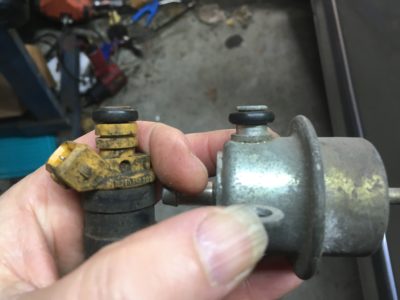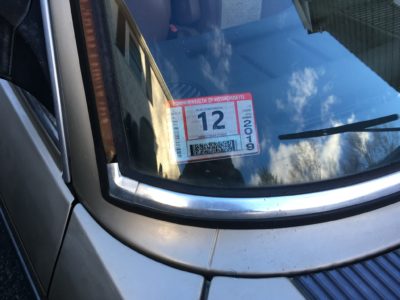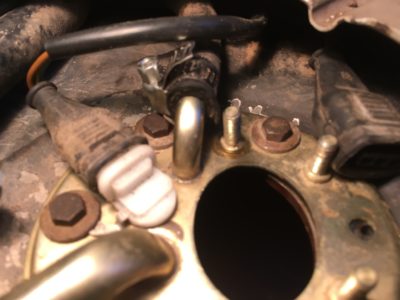Last week, I described driving the insured but unregistered Lama a bit farther than the around-the-block sort-out runs I’d been previously doing, and giving it its first real application of Lamathrust. I was pretty gentle; this was not a bonsai run to red line. After all, the car had previously suffered a broken rocker arm, and the fear of it happening again was crouching in the shadows. But nothing like that happened. Instead, I had a nice release of adrenaline and endorphins.
It did, though, unearth three new items to be added to the punch list. There was a bit of slippage of the power steering belt. There was a gas smell due to a small amount of fuel seeping from the o-ring under the fuel pressure regulator. And, when I looked under the car after I’d parked it, I found a small puddle of antifreeze.
Now, I said last week that I’d floated the car for sale on Facebook with the caveat that it was unregistered and thus could be driven around the block but no further, and had gotten interest but no real bites. There’s nothing wrong with selling an unregistered unsorted car, but the inability to give it a real test drive can definitely lower its value. From a buyer’s standpoint, the three small things I mentioned—the leaking antifreeze and fuel and the slipping power steering belt—are perfect examples of things that you expect to find on an unsorted car that’s been off the road for years, and that are baked into a lower price, but that shouldn’t be there in a fully-legal well-sorted car. From a seller’s standpoint, you’re likely to sell an unsorted unregistered car if you want to quit working on it and simply get rid of it. Plus, saying “It’s unregistered I’ve only driven it around the block I’m not presenting it as well-sorted” does buy you a certain amount of plausible deniability, paid for with a lower sale price. In contrast, if you want to maximize a car’s value, you’d never write up an ad that says “leaks a little fuel and coolant.” You’d fix those things. Then you’d keep driving the car to advance the sort-out process, and in order to do that without running afoul of the law, you’d register it.
And thus, in these three small issues, I found myself on the cusp of the decision on what to do with the Lama. After doing the goddamned head, am I supposed to not fix these things? I think not.

The value of never throwing anything away.
The fuel leak was fixed in five minutes by substituting an o-ring of the same size that I found on an old set of injectors (I put a new seal on order). The antifreeze leak was coming from where the lower radiator hose mates to the water pump. It was due to the fact that I’d been penny-wise and pound-foolish and had reused hoses even though the engine’s metal coolant necks had been corroded and some amount of corrosion had eaten into the rubber on the inside mating surface of the hoses. I drained the coolant and replaced the lower and upper radiator hoses, and the small C-shaped one as well. I tried filtering and re-using the coolant, but it had an oily tinge to it despite my having cleaned the catch basin. I felt like an idiot having to buy not only hoses but yet another gallon of Prestone. The slipping power steering belt was due to missing teeth on the cogged adjustment track. I procured a used one and installed it.
Having come this far, the decision itself was almost a formality. As reggae master Peter Tosh said, legalize it.
Unfortunately, in Massachusetts, that doesn’t come cheap. As I’ve written about previously, many years ago my state grew tired of people lying about what they paid for cars, and instituted a policy where the sales tax is assessed not on the basis of what you paid (or say you paid), but what the NADA low book value of the car is. Fortunately, a 1987 535i isn’t a 2002tii whose low book is now nearly thirteen grand. For the E28, it’s $2675, almost exactly twice what I paid for the car. Between the 6.25% tax on that, the $60 registration fee, $75 for a title, and $35 for state inspection, I was looking at forking over about $335 for the privilege of legality. (Yes, I’ve looked at becoming a dealer to get around this, but that carries with it other costs and restrictions that are prohibitive. Even if I’m going to turn a car around and sell it, I view paying these registration and inspection fees as a cost of passion.)
So one morning last week, I carefully scrutinized the car’s Florida title and bill of sale. The guy from whom I’d bought the car had never titled it; the “open title” and undated bill of sale were in the previous owner’s name. I began filling in my information, the date, and the mileage. I love my home state of Massachusetts, but this is the kind of thing where if you make a mistake and write something incorrect on the title (for example, accidentally signing on the seller’s line instead of the buyer’s), you descend into months of hell. Plus, here, because it was actually the previous owner’s title, if I botched an entry, the odds of getting a duplicate title were very slim. So I did it very carefully. I filled in my name and the date on the open bill of sale first, but when I went to the title, my heart stopped when I saw that, although the title was open (signed by the seller but not by a buyer), the date field had already been filled in during the car’s prior sale; it said “1/18/2018.” The Massachusetts registry will assess you a penalty if you don’t register a car within 30 days of purchase, and it accrues monthly. I looked carefully at the date, found a black pen that matched it, and deftly inserted a “1” next to the month so it read “11/18/2018.” I then took the title, the bill of sale, and the RMV-1 form sent by Hagerty to the registry. They scrutinized every single line on every piece of paperwork, but I walked out $300 lighter and with a fresh license plate and registration. (Note that I was not the buyer who bought the car on 1/18/2018; I paid my state every dime they were due.)
Next, inspection. You have seven days after registration to get a car inspected in Massachusetts. The police can stop you if they don’t see a valid inspection sticker on the windshield. If you show a less-than-a-week-old registration, you’re fine, but I prefer to knock off the inspection immediately, as sometimes you fail, and repairs or ordering needed parts takes longer than you thought. As I said last week, I’d clocked through what I thought were all of the car’s inspection-related needs, so I thought I was all set, except for one potential issue. The car has a small stone chip in the windshield. It’s off to the left side, not directly in the driver’s field of vision, so whether that’s fail-able is probably at an inspector’s discretion. Unfortunately, Massachusetts has one of the toughest motor vehicle inspections in the country, second only perhaps to California. All inspections are photographed from multiple angles, and the photos are then spot-reviewed. If an inspection station passes a car they shouldn’t have, they can lose their inspection license.

I don’t know why I always feel like I’ve gotten away with something when I pass inspection.
I took the car to the local service station I often use for inspection. I was waiting in line when I saw that, inside the inspection bay, was a gentleman wearing a jacket that said on the back “Mass DOT Inspection.” In other words, he was an inspection inspector. Figuring that his presence would make them even more rigorous than usual, I bailed and went to an unfamiliar station up the block. They flagged that the third brake light wasn’t working (something I hadn’t even checked) and the headlights were badly mis-aimed, but didn’t say anything about the stone chip in the windshield. I took the car back, replaced the burned-out brake light bulb, aimed the headlights in my garage, returned, and emerged victorious.
The Lama was legal. It was, at long last, time for a proper drive.
In my book Ran When Parked, I wrote extensively about the sort-out process, how you need to methodically progress from having a car start and run, to having it idle without dripping fluids or overheating, to moving the car 5 feet and verifying that the clutch works, to driving it 20 feet and verifying that it stops, to driving it 100 feet, then around the block, then a mile, then five miles, then 20, each time emerging with a punch list of things to repair. Other than the one short Lamathrust episode last week, the car had only really been around the block, perhaps 20 times. While everything felt good at 25 mph, typically a whole host of vibration and shimmy issues accompany a first drive at highway speeds.
I aimed the car at the section of I95 I often use for sort-out cruises. From the entrance ramp near my house up to Rt 2, it’s about ten miles. That stretch is perfect, as it has a breakdown lane, a service plaza with a gas station and a big parking lot, and multiple exists along the way, the first of which is only about a mile and a half. I’ve done this with many cars, most recently with the long sort-out of Bertha, during which I have vivid recollections of joyously mashing the throttle on the entrance ramp but bailing out at the first exit because the rumbling from the driveline was so loud I thought the trani or differential was about to self-destruct.
But in my maiden real drive in the Lama, I shifted through the gears, and the car settled in at 70. I passed the first exit. And the second. And the third. I drove it all the way up to Rt 2, and back down to my exit, in total about 20 miles. The car pulled hard in all gears, didn’t hesitate or stumble, felt free of driveline or wheel vibrations, and, incredibly, didn’t pull to one side on braking or have the brake pedal pulsate, an amazing feat considering that it was still running on the rotors and pads it wore for the five years it had been sitting. Even considering the twenty or so runs around the block and all the work I’d done over the past two and a half months (rebuilding the head, unclogging the fuel return line, replacing the crankshaft position sensor, the voltage regulator, the flexible brake lines, the water pump and most of the coolant hoses, and the SI board), this felt like a giant step, like Jake Sully in Avatar jumping out of bed and, against doctor’s orders, immediately running through the forest.

The epoxied-back-on stud can be seen at the center.
The only real problem occurred when I stopped for gas on the way home. After all, I’d been dumping in five gallons of fuel at a time from a gas can. I filled the car up, and soon discovered not only that the fuel level sender wasn’t working, but that the seal under the level sender was bad, causing the tank to leak when full. Further, when I removed the level sensor to replace the seal, I found that one of the posts holding it to the flange of the fuel pick-up tube had broken off. Fortunately, all three of these issues could be part of the same repair. E28 nice guy Aaron Manderbach (the gentleman who swapped me an SI board in exchange for a few beers and a signed book) sent me a level sender. I epoxied the broken-off post back in place, and installed the level sensor with a new o-ring.
So, the Hack States of Lama-dom appear to have progressed from:
- “Florida car. Starts, runs, drives, and stops (sort of). $1400 and $700 to ship. How can I go wrong?” to…
- “Oh dear god, what did I just buy… AND A BROKEN ROCKER ARM WHAT THE HELL?” to…
- “Dump it. Dump it now.” to…
- “No takers? Guess I’ll pull the head and replace the rocker.” to…
- “Looks like I have to redo the head, but it’s already off so what the hell.” to…
- “Head redone, starts, runs, drives, and stops (for real). Dump it. Dump it now.” to…
- “LAMATHRUST! but fix these three things.” to…
- “Legal Lama, and jeez, this thing runs great, but fix the fuel level sender.”
It takes about three weeks for the state of Massachusetts to send out a new title, so, until then, I couldn’t sell the car even if I wanted to. As long as the snow holds off, I’ll keep driving it and see how I feel about it. A number of folks have pointed out that the featured model at the Vintage 2019 will be the 5 Series (E12, E28, and E34), so the idea of holding onto the car through the spring, decorating it with every tacky “llamathrust” related sticker I can find, and running it down to Asheville has a lot of appeal.
In the meantime, the Lama’s punch list consists only of nonessential things like replacing the heater blower motor and the power antenna. Hell, to have something to do over the winter, I may have to start working on the Lotus. —Rob Siegel
Rob’s new book, Just Needs a Recharge: The Hack MechanicTM Guide to Vintage Air Conditioning, is available here on Amazon. His previous book Ran When Parked is available here. Or you can order personally inscribed copies of all of his books through Rob’s website: www.robsiegel.com.





















